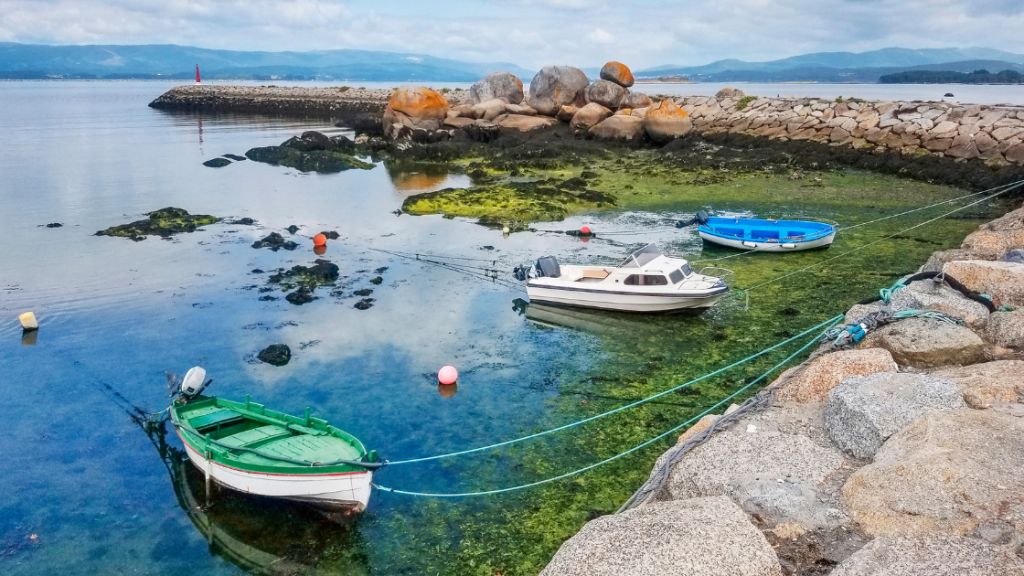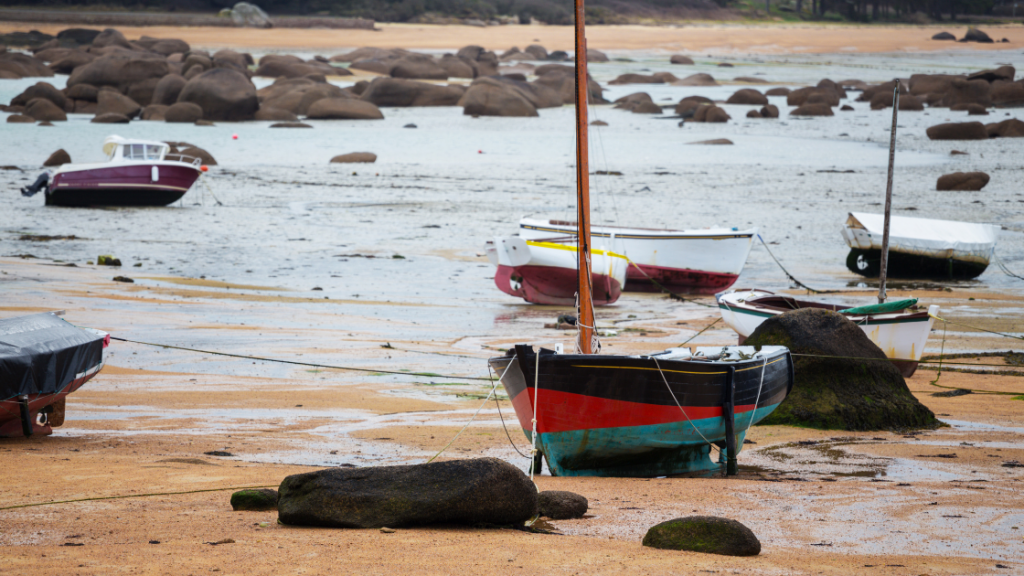Understanding Tides to Avoid Miscalculating Your Anchoring
February 14th, 2024 by team

by B.J. Porter (Contributing Editor)
On a family vacation in Maine as a kid, we went down to the beach at our campground to check it out. It was a nice sand beach, but it was clear the tide was out. We were curious just how far it was out, so we stuck a good sized stick sand at the waterline so we could measure how much the tide would come in later. But when the tide came in, the whole cove changed – the stick was under ten feet of water!
In a lot of coastal areas, tides aren’t such a big thing to worry about. The tide may swing a couple of feet, but in the end it’s not an enormous change in scope and there’s little risk. But what about anchoring in areas with significant tidal swings? What considerations do you need in places where the tide can swing ten feet or more when anchoring there is a new thing for you?
A large swing in tidal height coupled with a poorly calculated scope can lead to a dragging anchor. It’s far more important with large swings to make sure you have plenty of scope set. But that also creates a much bigger swinging circle at lower tides.
Scope Calculation

Figuring the correct scope for safe anchoring is a fundamental boating skill. Many good books cover the topic exhaustively, and we’ve even addressed it on this blog before.
We express scope ratios as a multiple of the total depth, adding it to the height of the chain above the water. This height is to the anchor roller above the water, not just the depth.
Depending on your rode type, the safe scope will be from 4:1 (for all chain rodes) up to 7:1 for rope/chain combination rodes. So if the maximum depth is eighteen feet and your bow roller is four feet off the water, you will multiply by 22 (18 + 4) to get the amount of rode to let out.
Errors in scope

People make two common mistakes when calculating scope. First, many boaters don’t take the height of the rode above the water into account. The other is neglecting or miscalculating the tides. Missing the height above the water can easily leave you 20-30 feet short of the scope you should have. And tidal errors can be larger and more subtle.
Judging the tides
It’s very common for a boater to read their depth sounder, make a quick calculation, drop the anchor and that’s it. And if you’re in the Chesapeake with a two-foot tide, or Florida with a three feet, that’s not likely to trip you up. But in Maine, with a potential swing of twelve feet or more in some places, it can be a disaster.
When you are planning to anchor, no matter where you anchor, check the tides when you arrive. There are a few easy ways to do this.
1) Check a physical tide table, book or website.
2) Many GPS and chart plotters have tide tables built into them. See if yours does, and learn how to use it. These are often powerful tools that let you skip the “educated estimate” we describe below.
3) If you can’t check a reliable table, observe the shoreline. Look for high tide marks on rocks, pilings, and other exposed areas. This won’t tell you the absolute swing of the tide in feet, but it will give you some idea how much the tide might come in.
Making an educated estimate
Better than eyeballing from shore marks or guessing, is making an educated calculation. It’s not that difficult. Eventually, you’ll get good at doing it quickly and you can round numbers to make the math simpler.
From your tide tables, you should be able to estimate how much tidal swing you’ll face. But with the following steps, you can approximate how much higher the tide will go.
- Figure the total tidal range for the largest swing of the day – this is the high height minus the low height.
- Check times the last tide and the next tide; one will be low, one will be high.
- Subtract the times. This will tell you how many hours are between the tides.
- Find the difference in hours between the current time and the closest high tide (before or after)
- Divide the results of Step 4 (time since/to High) by Step 3 (time between tides). This is a rough calculation of the percentage you are through the tide.
- Multiple the results of Step 5 by the total tide you calculated in Step 1.
This result is about how many additional feet of high tide you can expect from the current time until the highest tide in the next 24 hours. You can round to keep it simple. This is still an approximation, since tidal flows aren’t even.
Example Calculation:
We’re going to anchor in Portland, Maine around 2:30 P.M. on April 8th, 2024. Our tide data for that day is:
| Date | High Tide | Low Tide | |||||||
|---|---|---|---|---|---|---|---|---|---|
| AM | ft | PM | ft | AM | ft | PM | ft | ||
| 8 | Mon | 11:23 | 10.9 | 11:44 | 11.3 | 5:08 | -1.3 | 5:30 | -1.2 |
Our steps:
- High of 11.3′ – Low of -1.3′ = 12.6′ swing
- Last High, 11:23 AM, Next Low, 5:30 PM
- 11:23 AM to 5:30 PM is about 6.5 hours.
- Current time is 2:30 PM, and it’s 3:07 since the last high, or 3 hours.
- 3 hours / 6.5 hours = .462
- .Multiply 462 * 12.6′ swing = 5.8′
Based on this estimate, you still have just under six feet of tide to add by the next high tide just before midnight. And you can expect the depth to drop by roughly the balance of that (12.6′ – 5.8′), or another 6.8′ before low tide.
If your dept sounder currently shows you in 15′ of water, you can expect to be in about 8′ at low tide, and almost 21′ at high tide. If eight feet of water is a little tight for you at low tide, it might be a good time to pick another spot. It’s a good idea to give yourself some cushion, since an extremely low tide can still have you touching bottom.
Otherwise, we can proceed with the scope calculation using 21′ for the water depth, not the 15′ showing on your depth meter.
Effects of miscalculating the ride height

The effect is simple – if you do not account for the tidal swing, at high tide you may not have enough scope to keep your anchor from dragging.
In the above example, if you are setting 7:1 scope with a 4′ high bow roller, you should set out (21′ + 4′) * 7 = 175′ of rode. But if you use the 15′ you read from the depth sounder, you will only set (15′ + 4′) * 7 = 133′ of rode.
At the full high tide of 21′, your scope will only be 5:1, instead of the 7:1 you planned to set. If the wind blows up, you may scramble to deal with a dragging anchor.
Tidal Current Effects
One thing to note in extreme tidal areas is that strong, reversing current can accompany those big shifts. But even in a harbor like Nantucket, which only has a four foot tidal swing, those currents will turn your boat and swing your anchor. Anchored outside the mooring field in Nantucket harbor, the currents are strong enough to turn your boat away from the wind and drag your rode back and forth as the tide flows.
If you’re anchored out in a narrow seaway or a tidal river with pronounced current, the risk is continually re-setting the anchor in every tide cycle. Most times, letting out a little extra scope can help this, giving more holding power and a better chance for the anchor to dig back in if it pulls out.
If dragging is a problem, setting two anchors from the bow can solve it. Set anchor up current, the other down current. When the current reverses, the load goes between each anchor and the boat doesn’t move around too much. This is an advanced technique and should only be used when no other boats are around.
Extreme Tides, Currents and Other Boats

Those big tidal swings also mean you’ll have a lot of extra rode at low tide. In our example calculation, you’ll be at 7:1 at high tide, which is perfect. But at low tide, you’ll be in 8′ of water, and that 175′ of scope translates to a ratio of almost 15:1. That 12′ of tide means you’ve got an extra 84′ of rode at low tide, which increases your swinging radius quite a bit.
So pay attention to boats around you and try to set a similar amount of scope even if it’s slightly less than the 7:1 you want. If boats near you are setting 5:1 at high tide and you’re at 7:1, you’re going to swing a lot closer to them when the tide is out. Remember, that 7:1 ratio is the by-the-book ideal, but practically speaking a close anchorage may force you to use less, especially with a big tide.
- Posted in Blog, Boat Care, Boating Tips, Cruising, Fishing, iNavX, Navigation, Reviews, Sailing, Sailing Tips
- 2 Comments


February 16, 2024 at 2:06 am, Ron Sasiela said:
A good explanation and caution to observe. Further, know where the depth sounder’s transducer is calibrated from, as it often is NOT from the water’s depth! I may be at the bottom of the keel, or the thru hull position, so a correction is required. A leadline will answer that question.
September 25, 2024 at 1:10 am, B.J. Porter said:
Excellent point. We always offset ours to the keel, but we had to add 8′ back in to calculate the scope every time.